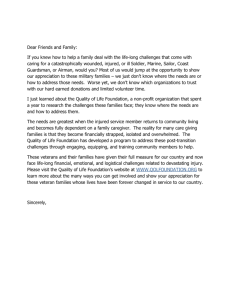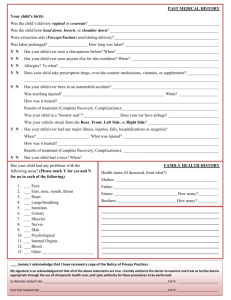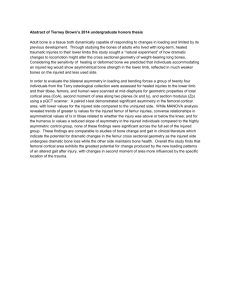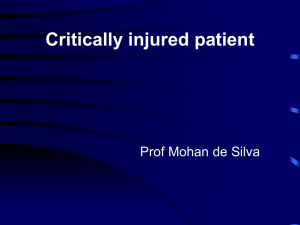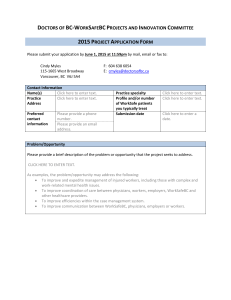Report - Univerzita Palackého v Olomouci
advertisement
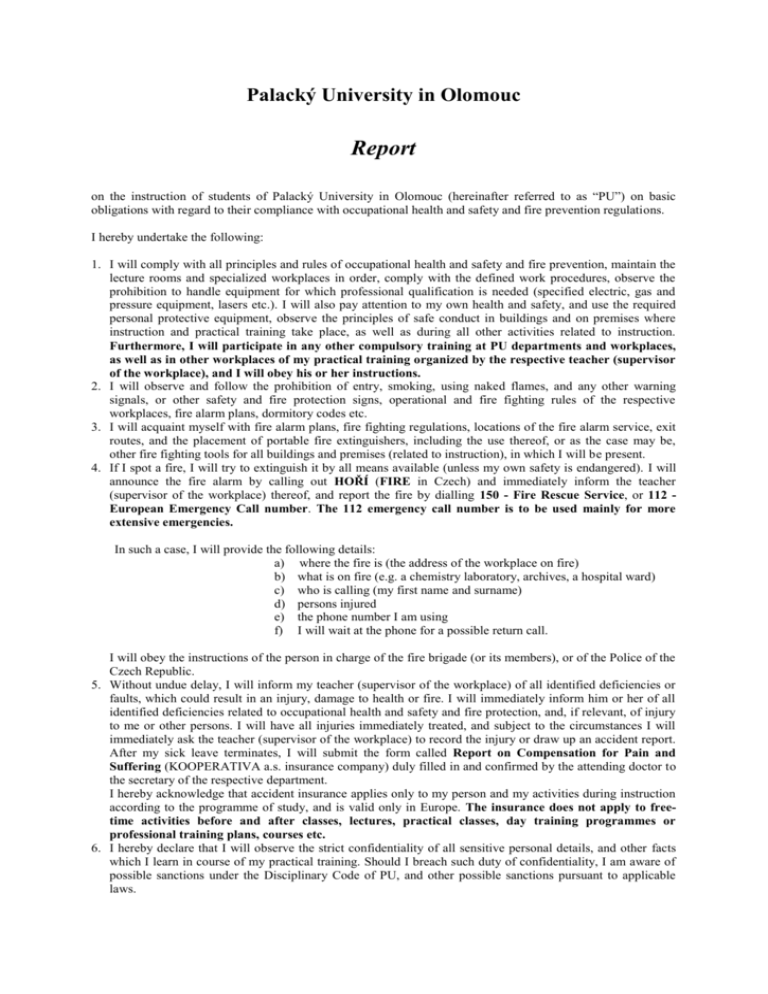
Palacký University in Olomouc Report on the instruction of students of Palacký University in Olomouc (hereinafter referred to as “PU”) on basic obligations with regard to their compliance with occupational health and safety and fire prevention regulations. I hereby undertake the following: 1. I will comply with all principles and rules of occupational health and safety and fire prevention, maintain the lecture rooms and specialized workplaces in order, comply with the defined work procedures, observe the prohibition to handle equipment for which professional qualification is needed (specified electric, gas and pressure equipment, lasers etc.). I will also pay attention to my own health and safety, and use the required personal protective equipment, observe the principles of safe conduct in buildings and on premises where instruction and practical training take place, as well as during all other activities related to instruction. Furthermore, I will participate in any other compulsory training at PU departments and workplaces, as well as in other workplaces of my practical training organized by the respective teacher (supervisor of the workplace), and I will obey his or her instructions. 2. I will observe and follow the prohibition of entry, smoking, using naked flames, and any other warning signals, or other safety and fire protection signs, operational and fire fighting rules of the respective workplaces, fire alarm plans, dormitory codes etc. 3. I will acquaint myself with fire alarm plans, fire fighting regulations, locations of the fire alarm service, exit routes, and the placement of portable fire extinguishers, including the use thereof, or as the case may be, other fire fighting tools for all buildings and premises (related to instruction), in which I will be present. 4. If I spot a fire, I will try to extinguish it by all means available (unless my own safety is endangered). I will announce the fire alarm by calling out HOŘÍ (FIRE in Czech) and immediately inform the teacher (supervisor of the workplace) thereof, and report the fire by dialling 150 - Fire Rescue Service, or 112 European Emergency Call number. The 112 emergency call number is to be used mainly for more extensive emergencies. In such a case, I will provide the following details: a) where the fire is (the address of the workplace on fire) b) what is on fire (e.g. a chemistry laboratory, archives, a hospital ward) c) who is calling (my first name and surname) d) persons injured e) the phone number I am using f) I will wait at the phone for a possible return call. I will obey the instructions of the person in charge of the fire brigade (or its members), or of the Police of the Czech Republic. 5. Without undue delay, I will inform my teacher (supervisor of the workplace) of all identified deficiencies or faults, which could result in an injury, damage to health or fire. I will immediately inform him or her of all identified deficiencies related to occupational health and safety and fire protection, and, if relevant, of injury to me or other persons. I will have all injuries immediately treated, and subject to the circumstances I will immediately ask the teacher (supervisor of the workplace) to record the injury or draw up an accident report. After my sick leave terminates, I will submit the form called Report on Compensation for Pain and Suffering (KOOPERATIVA a.s. insurance company) duly filled in and confirmed by the attending doctor to the secretary of the respective department. I hereby acknowledge that accident insurance applies only to my person and my activities during instruction according to the programme of study, and is valid only in Europe. The insurance does not apply to freetime activities before and after classes, lectures, practical classes, day training programmes or professional training plans, courses etc. 6. I hereby declare that I will observe the strict confidentiality of all sensitive personal details, and other facts which I learn in course of my practical training. Should I breach such duty of confidentiality, I am aware of possible sanctions under the Disciplinary Code of PU, and other possible sanctions pursuant to applicable laws. 7. I will observe the prohibition of drinking alcoholic beverages and using other addictive substances during lessons, as well as during other activities related to instruction. I may not attend lessons, nor take part in other activities related to my studies at PU, under the influence of alcohol or other addictive substances. Whenever there is a suspicion that I have used such substances, I will undergo a test to verify the consumption of alcohol or use of other addictive substances, if requested to do so. If I refuse to undergo such a test, I shall be deemed to be under the influence of the aforementioned substances. 8. I will report to my teacher (the supervisor of the respective workplace) any material change of my health status, which could result in an occupational accident or damage to health (e.g. asthma, epilepsy, pregnancy, sudden sickness etc.). 9. I acknowledge that I will be liable to PU in Olomouc for any damage which I cause during my theoretical and practical lessons, or as the case may be, during other activities related to my work at PU, by breaching my obligations or by intentional conduct contrary to good manners or disturbing the peace and quiet. The same shall apply if I fail to immediately inform the teacher, or the supervisor of my workplace of an imminent danger (and subsequent damage). 10. I will observe instructions of the manufacturers, operational, fire protection and emergency regulations of the respective workplaces. 11.During my practical training, I will refrain from entering workplaces and premises where I have not been sent by my teacher or by the supervisor of the workplace. 12. I will refrain from doing jobs for which I have not been trained, instructed in and which require professional qualifications. Safety regulations for persons without electrical engineering qualifications, who are professionally designated as persons who have been duly acquainted: Persons duly acquainted may only operate small and low voltage electrical devices within the sense of implementing regulations and local work and technological procedures. They are obliged to comply with operating and safety instructions, rules, guidelines, directives and manuals related to the work with electrical devices of the respective type and voltage. Persons duly acquainted are obliged to: Before moving or shifting work machines or appliances which are connected to the mains with a moveable supply line with a plug, safely disconnect such machines from the mains by pulling the plug out of the socket to avoid interruption, or by disengaging the supply lines. This requirement does not apply to such devices which have been particularly designed and adjusted to such a purpose, such as lights, some home appliances, manual electromechanical tools, etc. Inspect an electrical appliance or device before it is switched on; visually examine the condition of the electrical appliance or device with respect to safety and avoidance of electric shock. If the employee detects any defect on the device (such as tingling caused by the electric current, rattling, excessive heating of some part, unusually noisy or intermittent operation, defective insulation, smoke, jerky run-up or smell of burning), he or she must switch off the electrical device immediately, prevent its further use and report the defect to the manager of the workplace. It is prohibited to open electric power switchboards, switch on tripped circuit breakers, replace fuses etc. It is prohibited to use loosened or damaged sockets and switches. It is prohibited to work with electrical appliances and devices with wet hands, or if the appliances are wet. It is prohibited to use electrical appliances if their protective cover is missing. It is prohibited to strain moveable electric feed lines by pulling on them. It is prohibited to run electric feed lines over sharp edges. It is prohibited to use electrical appliances for purposes other than those for which they have been designated by the manufacturer. It is prohibited to strain electrical appliances or devices above the defined technical parameters. Damaged electrical appliances or devices must not be used!!! First aid for electric shock The rescuer must especially mind his or her own safety and must make sure not to get connected to the electric circuit, make sure while giving aid to stand on a non-conducting surface, not to touch metal objects, wet walls or the injured person’s wet clothes. The injured person himself or herself cannot release the object he or she is clutching as the electric current causes spastic muscle contractions. If the injured person is in such a position that he or she would fall down after disconnecting from the electric current or conductor (for instance, when holding a conductor on an electricity pylon, a ladder, etc., while not fastened with a belt), he or she must be secured from falling down, and therefore from further injury, before disconnecting from the electric current. For low voltage, it is possible to switch off power by the relevant switch, or by pulling the plug out of the socket. If this is not possible, remove the electric conductor in a suitable way using a dry, non-conducting material, such as rubber, at least a 30-centimetre long wooden stick, dry rope or cloth. The injured person must be pulled out (dragged) from contact with the electric current. If the electric power has not been switched off, the rescuer must not touch the injured person’s body or the wet parts of his or her clothes with their bare hands. If the injured person (or his or her clothes) burn because of the electric current or from any other cause, extinguish with dry cloth, preferably with a fireproof blanket, after switching off the electrical power. After rescuing the injured person from the electric current, the rescuer is obliged to provide first aid until the arrival of a medical doctor. The rescuer should not lose time by treating injuries such as minor bleeding, fractures or burns, but should instead concentrate on wounds that bleed profusely from an artery, which should be treating by covering with a provisional pressure bandage. If the injured person does not breathe in a normal way, artificial respiration and chest compressions must be started immediately. Even in the case of a light electric shock the injured person must be taken to a doctor. External cardiac massage and artificial respiration shall only be started if the injured person is unconscious and does not breathe in a normal way. External Cardiac Massage The rescuer shall place the injured person on a hard surface and kneel down to his or her chest. The palm edge of one hand of the rescuer shall be placed in the middle of the injured person’s chest and the palm edge of the other hand shall be put on top of the first one. The fingers of both hands shall be laced. The rescuer shall lean over the chest of the injured person so that the upper limbs of the former are stretched and perpendicular to the breastbone of the injured person, and shall start compressing the breastbone 100 times per minute to a depth of 4-5 centimetres. After each compression, the pressure on the chest shall be released, but the hands of the rescuer shall not lose contact with the chest of the injured person. Both the compression and relaxation shall last the same interval. If another rescuer is present, he or she should continue with oral resuscitation with the frequency of 2 breaths after every 30 chest compressions. The ratio of 30:2 is universal and shall be observed even if there is only one rescuer. If there are two or more rescuers, it is recommended that they take turns in doing chest compressions every 2 minutes. Artificial Respiration The first two artificial respirations shall take place after the chest has been compressed 30 times. As a rule, the oral cavity shall not be examined. The airways shall be cleared by bending the head of the injured person back and lifting his or her chin up, while he or she is lying on their back. The rescuer shall bend the head back with the palm edge of one of his or her hands placed on the forehead, and the fingertips of the other hand shall be used to lift the chin of the injured person up. In this position, the hand on the forehead shall press the nostrils between the thumb and the index finger, the thumb of the other hand shall be used to slightly open the mouth of the injured person, and the rescuer, during his or her normal inhalation, shall use his or her lips to embrace the mouth of the injured person and shall breathe the normal breathing volume out into the mouth of the injured person. Breathing in and out shall take about 1 second. At the same time, the rescuer is trying to watch the movements of the chest, signalling whether the respiration is done correctly. Important: The external cardiac massage shall only be interrupted for as short periods as possible (ideally only to make the 2 artificial respirations)! The provision of first aid may only be terminated if the rescuers have become exhausted, if the normal respiration of the injured person has resumed, or if the injured person has been handed over to professional rescuers. Only after the basic life support has been ensured will burns and fractures be treated. Any fractured extremity must be immobilized using splints. Wounds may bleed from veins (where blood pours continuously) or from arteries (blood spurts in an interrupted current). In the event of injuries caused by electric shock, it is essential not to move the injured person in any way, unless he or she has burns over large surfaces of their body, or is bleeding profusely from larger arteries. Never leave the injured person, not even for a moment!!! If the injured person is unconscious but breathes normally, has a palpable pulse and does not show any signs of a serious injury, he or she shall be placed into the recovery position on their side with head tilted back to free airways. The injured person must not drink anything or take any medicines. The injured person shall be under constant supervision and his or her breathing shall be monitored. If his or her condition changes, i.e. does not breathe normally, the injured person shall be put on his or her back and external cardiac massage and artificial respiration shall be started. Brief Summary of the Procedure for Providing First Aid 1. Act quickly, but calmly and purposefully. Make sure that the rescuer is safe in order to avoid further possible health hazard. 2. Remove the injured person from the electric current - by switching the current off, pushing the conductor away or pulling the injured person away. Beware of step voltage if high or very high voltage is involved! 3. Ascertain the mental condition (by shaking his or her shoulders and asking aloud -e.g. “Are you okay?” - “Jste v pořádku?”). 4. If the injured person does not respond, try to call for help in the surroundings - e.g. by calling “Help!” “Pomoc!”. 5. Turn the injured person onto his or her back, free his or her airways and watch whether he or she is breathing normally, i.e. breathes regularly, it is possible to feel the flow of air which is breathed out, to hear the breathing and see regular chest movements. 6. If the injured person breathes normally, he or she shall be placed in the recovery position. 7. If the injured person does not breathe normally, an ambulance shall be called for immediately by dialling 155 or 112. 8. External cardiac massage and artificial respiration in the 30:2 ratio shall be started immediately. (Start with 30 chest compressions!). 9. Call a medical doctor and inform the supervisor of the workplace (the teacher) as soon as possible. Important telephone numbers Phone number Czech Police - emergency calls Paramedic services - ambulance - 158 155 Instruction on portable fire extinguishers Water Portable Fire Extinguisher a) effect cooling b) suitable for extinguishing solid substances (wood, paper, textiles etc.) c) unsuitable for extinguishing flammable liquids (paints, oils, fats, solvents etc.) d) never use to extinguish electrical devices!!! Dry Powder Portable Fire Extinguisher a) effect reduces the energy required for burning and isolates the burning object from the surrounding air b) suitable for extinguishing solid substances (wood, textiles) extinguishing flammable liquids, extinguishing flammable gasses extinguishing live devices under voltage up to 1,000 V c) unsuitable for extinguishing loosely stored organic substances (sawdust, dust, etc.) Carbon-dioxide Portable Fire Extinguishers a) effect smothering, cools the burning object b) suitable for extinguishing flammable liquids extinguishing flammable gasses extinguishing live devices under voltage up to 1,000 V c) never use to extinguish the following: !!! loosely stored loose materials (sawdust, dust, wood shavings) d) do not use in small confined spaces I also acknowledge that I have been duly acquainted with the principles of occupational safety, namely: with occupational hazards and corrective actions while performing my job or related activities with the workplace, its surroundings and working conditions with technological and work procedures, or as necessary working with contagious and biological materials and methods for their disposal with instruction manuals for machinery, devices, electrical appliances, technical devices and tools, and with the use of working tools with safety signs, signage and signals 1) with the effects of hazardous substances and flammable liquids, with methods for their use and storage, corrective actions, first aid principles and required decontamination procedures and procedures for elimination of accidents, as well as safety instructions provided by the manufacturer of the hazardous substance, or flammable liquid, safety data sheets and instructions provided by the manufacturer on the label of the product 2) with the use of assigned personal protective equipment I hereby confirm by my signature that I have been acquainted with the basic obligations arising from the occupational health and safety and fire protection regulations, and that I have fully understood them. On………………………………………… ……… ………………………………………. Student’s first name and surname ..………………………………………………. Student’s signature 1) Only persons coming into contact with hazardous substances and flammable liquids. 2) Only persons who have been provided with personal protective equipment, or who use such equipment.
